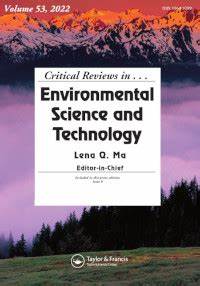Enzyme immobilization as a sustainable approach toward ecological remediation of organic-contaminated soils: Advances, issues, and future perspectives
IF 13.2
1区 环境科学与生态学
Q1 ENVIRONMENTAL SCIENCES
Critical Reviews in Environmental Science and Technology
Pub Date : 2023-02-23
DOI:10.1080/10643389.2023.2180285
引用次数: 5
Abstract
Abstract Removing recalcitrant organic contaminants from the soil via sustainable and environmentally friendly technologies are essential for environment and human health. Microbial enzyme is a promising biocatalyst, particularly in environmental bioremediation. To improve their stability and catalytic ability, enzymes are often immobilized on supporting materials. Nevertheless, the most appropriate immobilization technology and supporting materials must be selected in advance to achieve high eco-remediation efficiency. This review highlighted the recent advances and provided the future perspectives of immobilization techniques and supporting materials, with particular attention on ensuring basic features and possibilities of immobilized enzymes for eco-remediation of organic contaminated soil. The bioavailability, biodegradability and high cost of immobilized carriers have limited their industrial application and commercialization in remediation of organic contaminated soil, which was hereby thoroughly reviewed. Finally, future directions, including minimizing enzyme production costs, inexpensive and scalable immobilization carriers, and methods, were highlighted to offer new perspectives on the eco-remediation of organic contaminated soil. HIGHLIGHTS Immobilized approaches and carriers were classified and introduced. Immobilized enzymes have tremendous potential in soil eco-remediation. The main mechanism for soil remediation is the presence of a suitable microenvironment. Bioavailability, high cost and accessibility limited the large-scale applications. Future directions for soil eco-remediation with enzyme immobilization were proposed. GRAPHICAL ABSTRACT酶固定化作为有机污染土壤生态修复的可持续方法:进展、问题和未来展望
摘要通过可持续和环保的技术从土壤中去除顽固的有机污染物对环境和人类健康至关重要。微生物酶是一种很有前途的生物催化剂,特别是在环境生物修复方面。为了提高酶的稳定性和催化能力,通常将酶固定在支撑材料上。然而,必须提前选择最合适的固定化技术和支持材料,以实现高的生态修复效率。这篇综述强调了固定化技术和支持材料的最新进展,并提供了未来的前景,特别关注确保固定化酶用于有机污染土壤生态修复的基本特征和可能性。固定化载体的生物利用度、生物降解性和高成本限制了其在有机污染土壤修复中的工业应用和商业化。最后,强调了未来的方向,包括最大限度地降低酶的生产成本、廉价且可扩展的固定化载体和方法,为有机污染土壤的生态修复提供了新的视角。重点对固定化进近和载体进行了分类和介绍。固定化酶在土壤生态修复中具有巨大的潜力。土壤修复的主要机制是存在合适的微环境。生物利用率、高成本和可及性限制了大规模应用。提出了酶固定化土壤生态修复的发展方向。图形摘要
本文章由计算机程序翻译,如有差异,请以英文原文为准。
求助全文
约1分钟内获得全文
求助全文
来源期刊
CiteScore
27.30
自引率
1.60%
发文量
64
审稿时长
2 months
期刊介绍:
Two of the most pressing global challenges of our era involve understanding and addressing the multitude of environmental problems we face. In order to tackle them effectively, it is essential to devise logical strategies and methods for their control. Critical Reviews in Environmental Science and Technology serves as a valuable international platform for the comprehensive assessment of current knowledge across a wide range of environmental science topics.
Environmental science is a field that encompasses the intricate and fluid interactions between various scientific disciplines. These include earth and agricultural sciences, chemistry, biology, medicine, and engineering. Furthermore, new disciplines such as environmental toxicology and risk assessment have emerged in response to the increasing complexity of environmental challenges.
The purpose of Critical Reviews in Environmental Science and Technology is to provide a space for critical analysis and evaluation of existing knowledge in environmental science. By doing so, it encourages the advancement of our understanding and the development of effective solutions. This journal plays a crucial role in fostering international cooperation and collaboration in addressing the pressing environmental issues of our time.

 求助内容:
求助内容: 应助结果提醒方式:
应助结果提醒方式:


